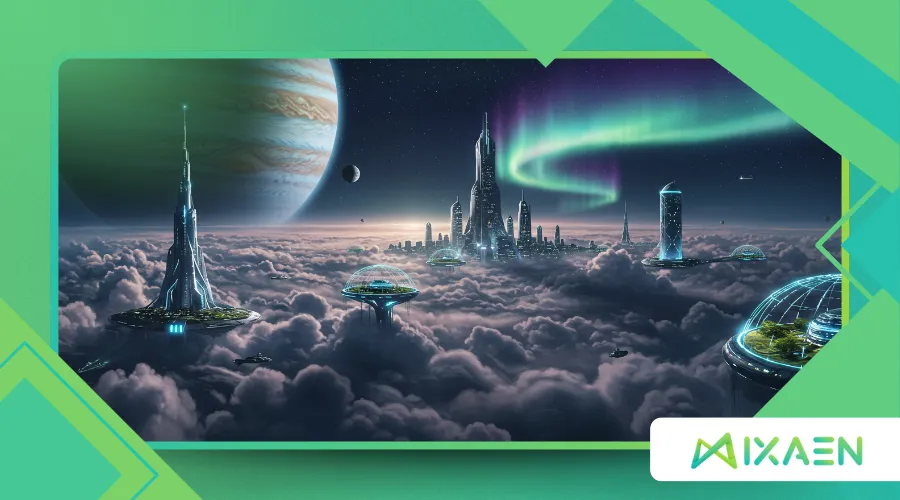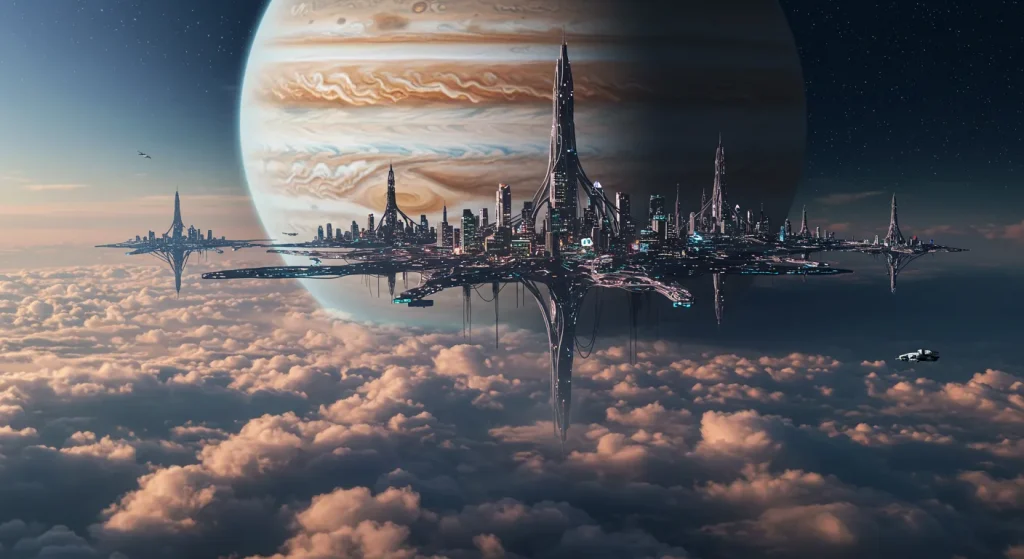What Would It Be Like to Live on Jupiter in the Future? Imagine a City in the Clouds

The idea of a human settlement floating among Jupiter’s violent storms sounds like science fiction—but what if we could live on Jupiter in colossal, airborne metropolises?
Anúncios
Unlike Mars or the Moon, Jupiter offers no solid ground; instead, future colonists might drift in self-sustaining cities suspended in the gas giant’s upper atmosphere.
This vision demands radical innovation, from unbreakable materials to artificial gravity, yet the rewards could redefine humanity’s place in the cosmos.
As we explore this possibility, we must consider the implications for our technology, society, and even our understanding of life itself.
Living in such extreme conditions would require a complete rethinking of how we design habitats and sustain life.
The potential for scientific discovery in such an environment is immense, as we could learn more about gas giants and their atmospheres than ever before.
Why Jupiter? The Allure of a Gas Giant
Jupiter’s sheer scale is staggering.
Its magnetic field is 20,000 times stronger than Earth’s, and its Great Red Spot alone could swallow our planet whole.
Yet, within its turbulent skies lies a narrow band of habitability.
At roughly 50 kilometers above the visible cloud layers, temperatures and pressures resemble Earth’s, making it the only plausible zone where we might live on Jupiter.
This unique environment poses both opportunities and challenges for future colonists.
A 2021 study by the Journal of Astrobiology and Space Science suggested that microbial life could exist in Jupiter’s atmosphere, feeding on chemical compounds like ammonia.
If extremophiles survive there, could we engineer habitats to do the same?
The possibility of discovering new life forms in Jupiter’s clouds could revolutionize our understanding of biology and the limits of life.
Table 1: Jupiter vs. Earth – Key Comparisons
| Feature | Jupiter | Earth |
|---|---|---|
| Surface Gravity | 2.5x stronger | 1g |
| Atmospheric Pressure | Crushing at depth | 1 bar at sea level |
| Radiation Levels | Extreme | Moderate |
| Temperature Range | -145°C to 21,000°C | -88°C to 58°C |
These comparisons highlight the drastic differences we would face living on Jupiter compared to Earth.
Understanding these differences is crucial for developing the technology needed for survival in such an extreme environment.
Floating Cities: Engineering a Sky-Bound Civilization
Imagine a network of dirigible-like habitats, buoyed by hydrogen or helium, drifting in Jupiter’s upper atmosphere.
These structures would need to be both lightweight and indestructible—perhaps constructed from graphene or aerographite, materials stronger than steel but lighter than air.
One radical concept involves fusion-powered sky anchors, massive reactors that harvest helium-3 from Jupiter’s atmosphere to generate energy.
Unlike Earth’s dwindling resources, Jupiter’s endless supply of hydrogen isotopes could sustain fusion for millennia.
This energy source could provide the necessary power for life support systems, agriculture, and transportation within the floating cities.
Additionally, the use of renewable energy sources could make these habitats self-sufficient, reducing reliance on Earth for resources.
+ Proxima Centauri and Its Planets: The Best Candidate for Life Beyond Earth?
Example 1: The Aurora Colony
Picture Aurora, a floating city where transparent domes filter Jupiter’s radiant auroras into artificial daylight.
Residents work in vertical farms growing genetically modified crops, while drones mine the atmosphere for rare gases.
The colony’s centrifugal rings simulate gravity, preventing muscle atrophy—a necessity when Jupiter’s pull would otherwise turn human bones to jelly.
These innovations would not only enhance living conditions but also ensure the long-term survival of the colony.
As technology advances, we could see even more sophisticated solutions to the unique challenges of living on Jupiter.

Surviving the Storm: Challenges of Jupiter’s Extremes
Living on Jupiter isn’t just about floating—it’s about surviving.
Hurricane-force winds, radiation storms, and lightning strikes 1,000 times more powerful than Earth’s would test even the most advanced engineering.
Shielding would require layers of water or superconductive alloys to deflect cosmic rays.
And then there’s the food problem.
Without soil, agriculture would rely on aeroponics or lab-grown meat.
Waste recycling would need near-perfect efficiency; a single system failure could doom an entire city.
To address these challenges, researchers would need to develop robust systems for food production, energy generation, and waste management.
Exploring innovative agricultural techniques could lead to breakthroughs not only for Jupiter but for sustainable living on Earth as well.
Table 2: Daily Life on Jupiter vs. Earth
| Aspect | Jupiter Colony | Earth |
|---|---|---|
| Gravity | Artificial (0.8g) | Natural (1g) |
| Energy Source | Helium-3 Fusion | Fossil/Solar |
| Food Production | Aeroponic Towers | Traditional Farms |
| Transportation | Airships & Drones | Cars/Planes |
These comparisons illustrate the significant adjustments that would be necessary for daily life on Jupiter.
The unique challenges of living in a gas giant would foster innovation and creativity in problem-solving.
++ Discover the Exoplanets Where It Rains Diamonds and Their Fascinating Facts
The Psychological Toll: Isolation in an Infinite Sky
Humans evolved on solid ground—how would we cope floating in an endless abyss?
Studies on Antarctic and ISS crews show that confinement and isolation lead to depression and conflict.
Now amplify that: no sunrise, no horizon, just an eternal sea of swirling clouds.
Yet, there’s a strange beauty in this existence.
Imagine stepping onto an observation deck, watching ammonia cyclones rage below while Jupiter’s moons rise like jewels in the sky.
Would the awe outweigh the fear?
Creating communal spaces and recreational activities could help mitigate the psychological effects of isolation.
Incorporating art, music, and social gatherings into daily life could foster a sense of community among residents.

The Bigger Picture: Jupiter as a Stepping Stone
If we master floating cities here, the same technology could apply to Saturn, Uranus, or even gas giants beyond our solar system.
Jupiter could become a refueling hub for deep-space missions, leveraging its gravity well for slingshot maneuvers.
For more insights into space exploration, check out NASA’s official website.
Example 2: The Cloud Cartel
A speculative future might see corporate entities vying for atmospheric mining rights, extracting hydrogen and helium-3 to power Earth’s fusion reactors.
The first trillionaires won’t be asteroid miners—they’ll be the tycoons who harness Jupiter’s storms.
This potential for economic opportunity could drive further exploration and investment in gas giant colonization.
As we look to the future, the implications of living on Jupiter extend beyond survival; they could reshape our economy and society.
Conclusion: A Leap of Faith Into the Clouds
To live on Jupiter is to embrace the unknown.
The challenges are monumental, but so are the possibilities.
Floating cities could become humanity’s most audacious achievement—or its most spectacular failure.
One question lingers: If we can conquer Jupiter’s skies, what’s left to fear in the universe?
Exploring these possibilities could inspire future generations to reach for the stars, pushing the boundaries of human potential.
